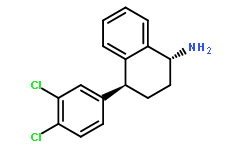| Cas No.: | 675126-05-3 |
| Chemical Name: | 1-Naphthalenamine, 4-(3,4-dichlorophenyl)-1,2,3,4-tetrahydro-,(1R,4S)- |
| Synonyms: | 1-Naphthalenamine, 4-(3,4-dichlorophenyl)-1,2,3,4-tetrahydro-,(1R,4S)-;(1R,4S)-4-(3,4-dichlorophenyl)-1,2,3,4-tetrahydronaphthalen-1-amine;DASOTRALINE |
| SMILES: | ClC1C(Cl)=CC(=CC=1)[C@H]2C3C(=CC=CC=3)[C@H](N)CC2 |
| Formula: | C16H15NCl2 |
| M.Wt: | 292.203 |
| Purity: | >98% |
| Sotrage: | 2 years -20°C Powder, 2 weeks 4°C in DMSO, 6 months -80°C in DMSO |
| Description: | Dasotraline is a triple reuptake inhibitor that blocks dopamine, norepinephrine, and serotonin transporters with IC50 values of 4, 6, and 11 nM, respectively. |
| Target: | IC50: 4 nM (dopamine transporter), 6 nM (norepinephrine transporter),11 nM (5-HT transporter)[1] |
| In Vivo: | The present in-vivoelectrophysiological study is undertaken to determine the effects of the triple reuptake inhibitor Dasotraline (SEP-225289) on the neuronal activities of locus coeruleus (LC) NE, ventral tegmental area (VTA) DA and dorsal raphe (DR) 5-HT neurons. Administered acutely, Dasotraline dose-dependently decreases the spontaneous firing rate of LC NE, VTA DA and DR 5-HT neurons through the activation of α2, D2 and 5-HT1A autoreceptors, respectively. Dasotraline predominantly inhibits the firing rate of LC NE neurons while producing only a partial decrease in VTA DA and DR 5-HT neuronal discharge. Dasotraline is equipotent at inhibiting 5-HT and NE transporters since it prolongs to the same extent the time required for a 50% recovery (RT50) of the firing activity of dorsal hippocampus CA3 pyramidal neurons from the inhibition induced by microiontophoretic application of 5-HT and NE. The recovery time (RT), from the suppression of hippocampus pyramidal neuron firing activity following microiontophoresis application of 5-HT and NE, is assessed by determining the RT50 values before and after the acute intravenous administration of cumulative doses of Dasotraline (1–8 mg/kg). Although Dasotraline (1 and 2 mg/kg) does not modify the firing activity of CA3 pyramidal neurons, a significant reduction (∼50%) is detected with the highest dose (8 mg/kg). In rats pre-treated with WAY100635, Dasotraline (0.5-2 mg/kg i.v.) elicits a significant increase in DR 5-HT firing rate. In rats pre-treated with WAY100635, Dasotralinesignificantly increases the number of single spikes and bursts[1]. |
| References: | [1]. Guiard BP, et al. Characterization of the electrophysiological properties of triple reuptake inhibitors on monoaminergic neurons. Int J Neuropsychopharmacol. 2011 Mar;14(2):211-23. |

 DC Chemicals' products qualify for U.S. tariff exemptions. We guarantee no price increases due to customs duties and maintain stable supply, continuing to deliver reliable research solutions to our American clients.
DC Chemicals' products qualify for U.S. tariff exemptions. We guarantee no price increases due to customs duties and maintain stable supply, continuing to deliver reliable research solutions to our American clients.





















